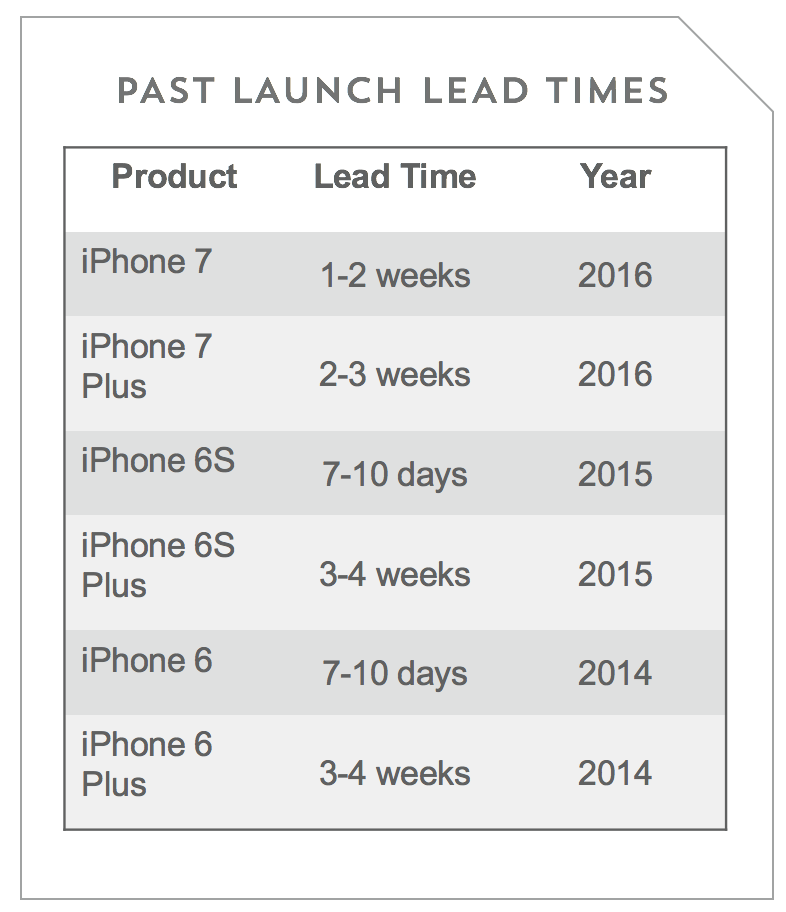
As you know, Apple will begin taking iPhone X pre-orders this Friday, Oct 27 at 3am ET. Here is a helpful how to on pre-ordering your iPhone X. Given well-documented production bottlenecks (screen and TrueDepth camera) we expect lead times for both capacities to reach 4-6 weeks by 8am ET and remain largely unchanged in the days to follow. We expect lead times of 4-6 weeks for the month of November. We believe the iPhone X will reach global supply-demand equilibrium sometime in the March quarter, or 3-4 months after launch. Typically it takes 2-3 months for a new iPhone to reach global supply-demand equilibrium.
iPhone X Will Make Or Break Story Over The Next Year. The iPhone mix and ASP will be the biggest driver of AAPL shares in the next year, which we expect to be favorable to the story. At first take the $1000 starting price iPhone feels like a deal breaker. We think that’s a fallacy, and consumers will take a step function jump in what they’re willing to spend on an iPhone given most buy their phones on installment plans. week we raised our estimates on AAPL with our updated model (here). For FY18, we raised our iPhone ASP to $740 vs. Street at $696 (up 15% y/y), revenue to $273 billion vs. Street at $265 billion, and EPS to $11.25 vs. Street at $11.05. We’re moving 7m iPhones from Dec-17 (now at 77.5m vs. Street at 82m) to Mar-18 (now at 64.5m vs. Street at 61m) to account for production constraints of the iPhone X. For FY18 we’re expecting 238m iPhones, up 9% y/y vs. Street at 242m.

Interpreting the Lead Times. While far from an exact science, we want to give a framework about how we are thinking about lead times. In general, if we see lead times of 4-6 weeks the morning of Oct. 27th as a sign that demand for the iPhone X is trending more favorable than investor expectations. If by Sunday, the 29th lead times are below two weeks we’d be concerned about underlying demand.
History of iPhone Launch Lead Times. To put our expectations of an iPhone X 4-6 week lead time into perspective, we went back and looked at lead times for the three previous iPhone cycles. The table below outlines iPhone lead times two days after pre-orders began. The takeaway is the average lead time over the previous three cycles was just over two weeks (15.6 days to be exact). In other words, we expect the lead time to be an order of magnitude greater for the iPhone X.
 Source: Apple.com
Source: Apple.com
Are Lead Times a Good Indicator of Demand? In two of the last three cycles, lead times have been a directional indicator of demand. For example, for the iPhone 7 Plus and the iPhone 6 Plus lead times were 2-3 weeks and 3-4 weeks, respectively. Both of these products were part of a cycle that exceeded investor expectations. The iPhone 6S Plus also had 3-4 week lead times, but delivered a 1% iPhone unit miss (74.8m versus Street at 75.5m) in its initial Dec-15 launch quarter. Three data points does not make a trend, but is a helpful observation in decoding the upcoming iPhone X lead times.
Apple Does Not Purposefully Create Long Lead Times. Around launches there is a common accusation that Apple purposefully creates long lead times to build the narrative that its products are in high demand. Our coverage of Apple has made us confident that Apple does not manipulate lead times. There are two reasons why we believe this. First, Apple is a hyper-competitive company and would want to capitalize on selling a product when someone wants to buy the product and avoid a lead time defection. Second, Apple is a big company. If someone is responsible for manipulating lead times, they would have likely leaked this explosive fact to the media. You can’t keep something that big a secret for this long.
Disclaimer: We actively write about the themes in which we invest: artificial intelligence, robotics, virtual reality, and augmented reality. From time to time, we will write about companies that are in our portfolio. Content on this site including opinions on specific themes in technology, market estimates, and estimates and commentary regarding publicly traded or private companies is not intended for use in making investment decisions. We hold no obligation to update any of our projections. We express no warranties about any estimates or opinions we make.